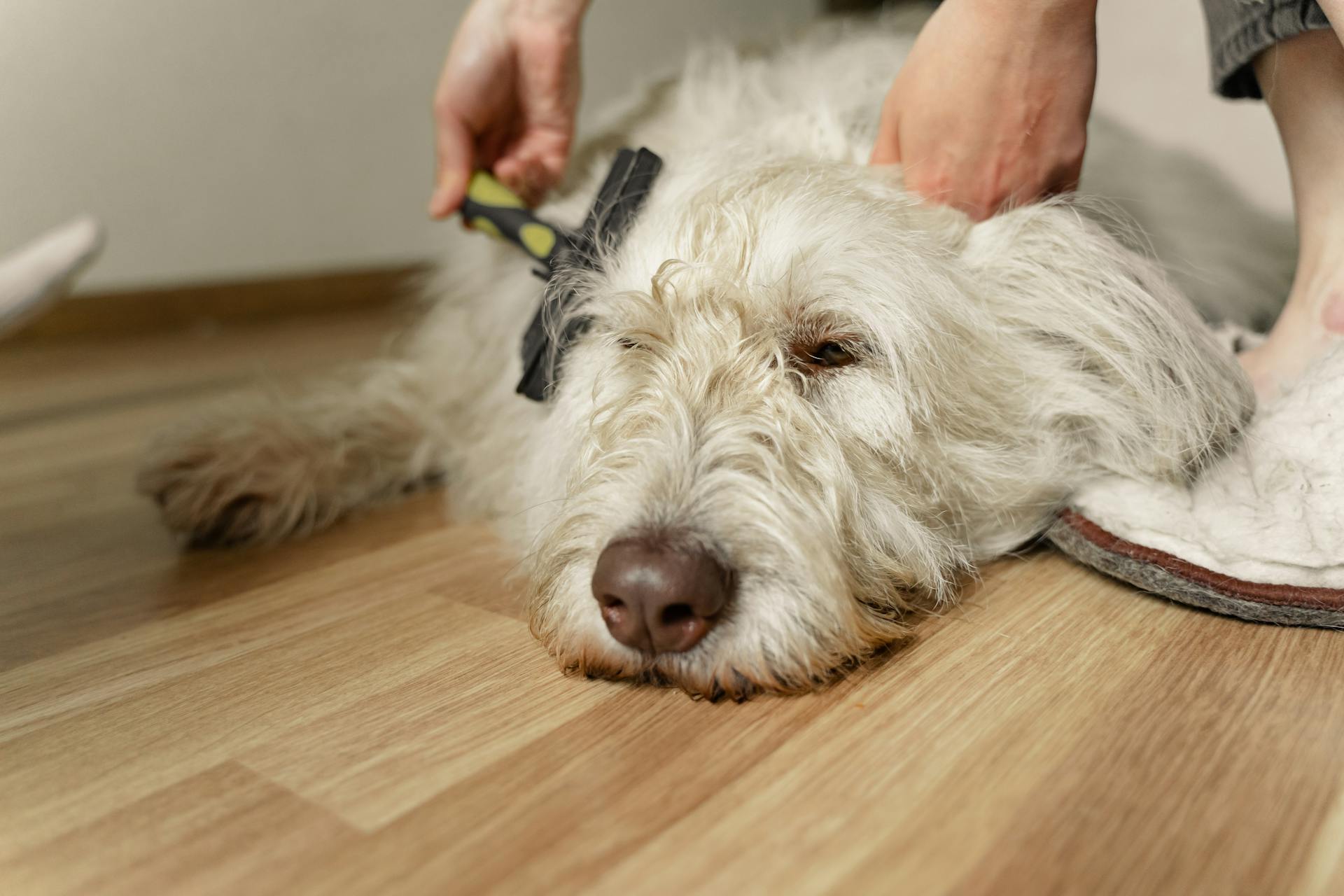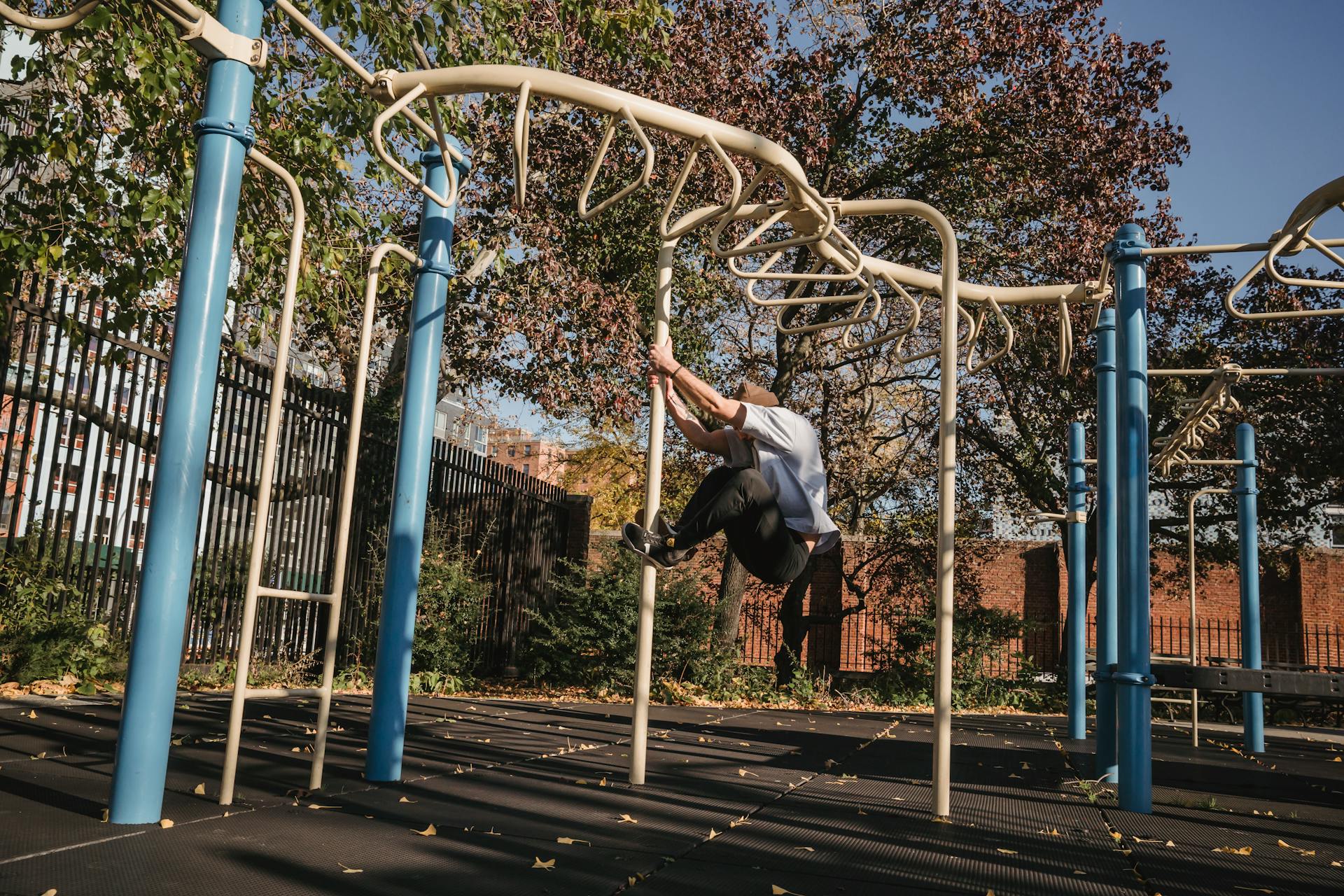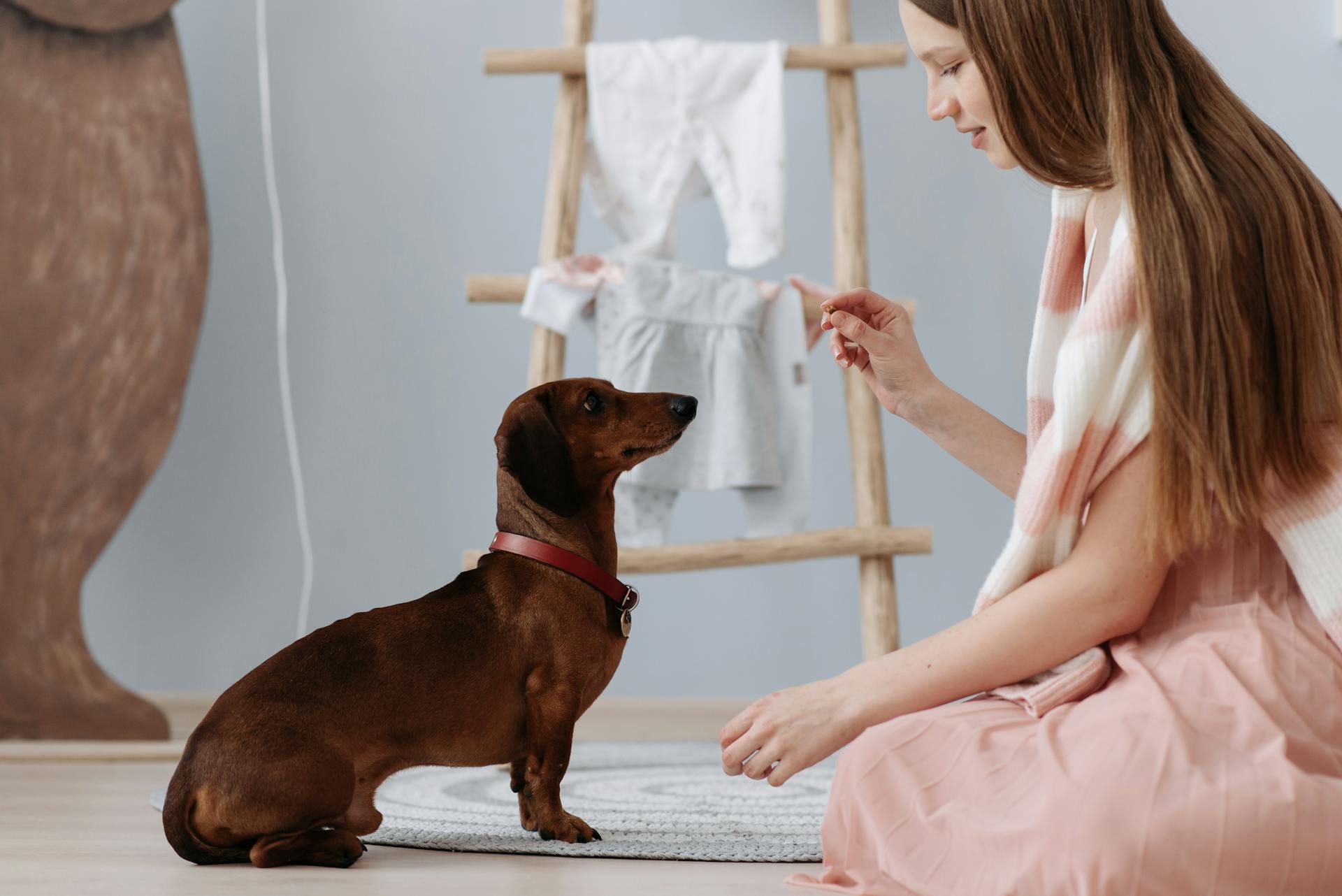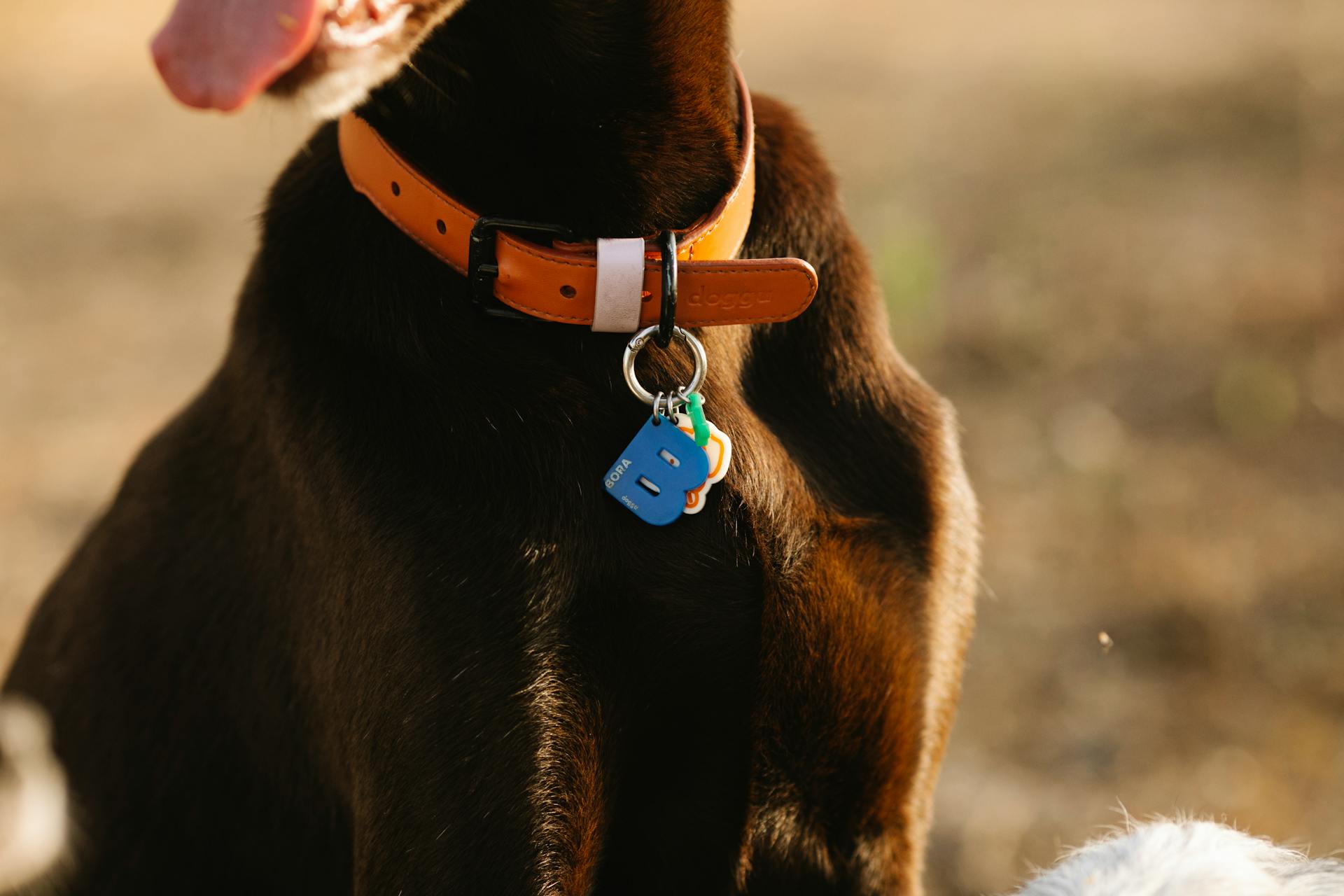
Grooming your dog at home can be a great way to bond with your pet and save money on professional grooming costs. Regular grooming can also help prevent health issues like matting and tangling.
Brushing your dog's coat is a crucial part of their grooming routine, and it's best to brush them at least 2-3 times a week. This frequency helps prevent tangles and mats, especially in long-haired breeds.
Many dog owners find it helpful to use a deshedding tool to remove loose hair and prevent shedding. These tools are especially useful for dogs with thick or double coats.
With practice and patience, you can become a pro at DIY dog grooming.
DIY Dog Grooming Basics
Getting started with DIY dog grooming requires the right tools and a little bit of knowledge. You'll want to invest in good quality items that will work effectively and last a long time. The specific tools you need will depend on your dog's breed and the range of grooming tasks you're willing to take on.
A good place to start is with a basic tool kit that includes an electric clipper, such as the Andis 23320 Professional UltraEdge Super 2-Speed Detachable Blade Clipper. This will help you with tasks like nail trimming and ear cleaning, which can be a bit daunting for beginners.
You'll also want to invest in a grooming table, like the Pingkay Heavy Duty Pet Professional Dog Show Foldable Grooming Table, to give your dog the support and comfort they need during grooming sessions. A grooming table will help you perfectly position your dog and make the process much easier.
Brushing is an essential part of dog grooming, and using the right brushes and combs can make a big difference. Specialized dog brushes, like undercoat rakes and slicker brushes, are designed to reach through both the topcoat and the downy undercoat without scratching your dog's skin.
Daily brushing is recommended for many breeds, and using the right pet brush can help reduce pet shedding. You can find a wide range of dog brushes, including rubber brushes and shedding blades, to suit your dog's coat type.
As for how frequently you should groom your dog, it depends on their breed, coat type, and individual needs. Daily brushing is recommended for many breeds, but grooming practices like bathing, fur trims, and nail cutting should be done every 4-8 weeks.
You might enjoy: Electric Dog Grooming Table
Dog Grooming Techniques
Brushing your dog's coat regularly is a must, as it removes excess hair and helps distribute natural oils in their fur and skin. This can be done daily, but at least once a week is better for most medium to long-haired dogs.
Daily brushing is a must for longer silky breeds, such as the Bearded Collie, to keep their coats tangle-free. Short-haired breeds, like Pitbulls, can benefit from daily brushing with a gentle bristle brush or rubber brush to smooth the coat and stimulate natural oil production.
Regular brushing gives you a chance to inspect your dog's coat for signs of matting, tangling, or any skin issues. This includes checking for lumps, ticks, fleas, and cuts.
Check this out: All Breeds Dog Grooming
Self-Serve Wash and Bathing
Self-serve dog wash stations are a convenient and practical way to bathe your dog. They often have everything you need right there, from shampoo to blow dryers, making it easy to get the job done.
First, brush your dog thoroughly before bathtime to remove loose dirt and hair, making the bath more effective. Brushing your dog before bathtime is a good idea because it helps remove loose dirt and hair, making the bath more effective.
To use a self-serve dog wash station, take your dog on a leash into the facility and secure the leash to a hook to keep your dog in place. Secure the leash to a hook to keep your dog in place.
Cautiously remove any matting or burrs in your dog's fur before bathing, as they can be painful for your dog. Removing matting or burrs before bathing is a good idea because it makes the bathing process easier and less painful for your dog.
Here are some tips for bathing your dog at a self-serve dog wash station:
- Be very careful not to get water in your dog's ears, as it can be irritating and lead to infection.
- Wash your dog from the neck down to avoid getting water or shampoo in their eyes.
- Use special wipes designed for cleaning the ears and around the eyes.
- Go slowly with the blow dryer, introducing it gradually if your dog is afraid of the noise.
- Check the blow dryer heat setting to ensure it's not too hot for your dog.
By following these tips and using the right products, you can make bathing your dog a positive experience for both of you.
Deshedding and Hair Care
Deshedding tools are designed to remove dead hair that is still loosely attached, but not live hair with roots. Most deshedding tools should be used less frequently than regular brushing, ideally weekly, to prevent pulling out live hair.
Using the right deshedding tools is crucial, and it's essential to choose tools that are designed for your pet's specific coat type. Many deshedding tools are designed to not only remove loose hair but also gently pull out dead hair that may still be attached to the follicle.
The FURminator deshedding tool is a popular and highly recommended option for dogs, and it's especially effective for removing dead hair that's embedded in fabrics. Regular deshedding practices can help desensitize your pet to the grooming process, making it less intimidating for them.
Deshedding can significantly reduce the amount of dog hair that floats around your house, and it's an essential part of maintaining your pet's skin and coat health. By deshedding your dog regularly, you can also help prevent matting, tangles, and breakage.
Curious to learn more? Check out: Dog Grooming Deshedding
Brushing your dog is a crucial part of deshedding, and it's essential to use the right brushes and combs for your pet's specific coat type. Specialized brushes and combs made just for dogs are designed to reach through both the topcoat and the downy undercoat without scratching your pet's skin.
Double-coated breeds, such as Huskies and German Shepherds, will generally have a large shed in the spring when the weather turns warm, and they may need to be brushed as much as twice a day for a week or two until the undercoat is gone.
A fresh viewpoint: Dog Hair Everywhere Pet Grooming
Nail Care and Trimming
Trimming your dog's nails is an essential part of DIY dog grooming. It's a simple task that can be done at home, but it's crucial to do it correctly to avoid causing pain or injury to your dog.
You'll want to trim your dog's nails a couple of times a month to prevent overgrowth, which can be painful for your dog to walk on. Not trimming their nails regularly can also lead to infections.
Related reading: How to Cut a German Shepherds Nails
There are two types of nail clippers: scissors type and guillotine. Most dog professionals prefer the scissors type to prevent injury.
Before clipping, gently separate your dog's toes and trim away excess hair to prevent dulling your nail clipper. Then, clip the tip of each nail, taking care not to cut too much at once.
If you accidentally cut too deep, use styptic powder or cornstarch to stop the bleeding. It's better to trim a little at a time and check your progress than to risk cutting into the quick.
Overgrown nails can affect your dog's gait and posture, and if left unchecked, can even cause long-term problems like lameness and joint degeneration.
Curious to learn more? Check out: Dog Grooming with Scissors
Grooming for Specific Needs
Some dogs require extra care when it comes to grooming. For example, dogs with wrinkled faces and bodies, like French bulldogs, need to have their skin folds cleaned and dried daily to prevent skin irritations and infections.
Dogs with curly coats, such as Airedales and cocker spaniels, need daily brushing to prevent painful mats from forming. Curls can trap loose hair and shampoo, so be sure to rinse thoroughly after bathing.
Dogs with floppy or hairy ears, like Afghan hounds and basset hounds, need more frequent ear cleaning to prevent infection. Give their ears a wipe each week and consider plucking excess hair with special tweezers designed for dog ears.
Here are some specific breeds that require extra care:
- French bulldog, Shar-Pei, Neapolitan mastiff, and pug: Wrinkled faces and bodies require daily skin fold cleaning and drying.
- Airedale and cocker spaniel: Curly coats require daily brushing and thorough shampoo rinsing.
- Afghan hound and basset hound: Floppy or hairy ears require weekly cleaning and possible hair plucking.
- Standard poodle and Irish water spaniel: Non-shedding coats require daily brushing and occasional trimming.
- Shih Tzu and Maltese: Short-nosed breeds require daily eye rinsing and fur trimming to prevent tear stains.
Clean Teeth
Brushing your dog's teeth is an important part of grooming that can save you hundreds of dollars a year by preventing dental disease, which can lead to heart, kidney, and liver problems.
It's best to take it slow when brushing your dog's teeth, starting with just a little bit of toothpaste and plenty of praise and reward.
Dental disease is a serious issue that can be avoided with regular brushing, making it a crucial part of your dog's grooming routine.
You can make brushing your dog's teeth a positive experience by using a pleasantly flavored toothpaste designed for dogs.
With patience and consistency, your dog will learn to look forward to this daily routine, and you'll be able to keep their teeth clean and healthy.
Breed-Specific Considerations
Some breeds require a little extra care when it comes to grooming. French bulldogs, Shar-Peis, Neapolitan mastiffs, and pugs have wrinkled faces and bodies that need special attention to prevent skin irritations and infections.
Dirt and moisture can become trapped in those skin folds, so it's essential to clean and dry each fold of skin daily. You can use special wipes or a washcloth and gentle cleanser to do this.
Curly-coated breeds like Airedales and cocker spaniels need daily brushing to prevent painful mats that form from accumulated hair. These mats can pull on the skin, so regular brushing is a must.
Floppy or hairy ears are more prone to infection in breeds like Afghan hounds and basset hounds. Give their ears a wipe each week to remove dirt, and consider plucking excess hair with special tweezers designed for dog ears.
Non-shedding breeds like standard poodles and Irish water spaniels need daily brushing and occasional trimming to keep their coats tidy and prevent matting.
Check this out: Mats Dog Grooming
Short-nosed breeds like Shih Tzus and Malteses tend to tear more, which can lead to staining. Rinse their eyes daily with a special canine eyewash product to prevent tear stains.
Here are some breed-specific grooming considerations to keep in mind:
- Wrinkled breeds: Clean and dry skin folds daily.
- Curly-coated breeds: Brush daily to prevent mats.
- Floppy or hairy ear breeds: Wipe ears weekly and consider plucking excess hair.
- Non-shedding breeds: Brush daily and trim occasionally.
- Short-nosed breeds: Rinse eyes daily to prevent tear stains.
Double-coated breeds like Huskies and German Shepherds develop a thick undercoat in the winter months, which sheds heavily in the spring. Brush them as much as twice a day for a week or two until the undercoat is gone.
Long Growth Breeds
Long growth breeds, such as Poodles and Shih Tzus, have hair that will continue to grow indefinitely until it's cut.
These breeds often have hair that doesn't die and shed regularly, leaving less hair behind in carpets, drapes, and furniture.
For dogs with long growth hair, haircuts are a required grooming practice, and you may need to give your dog a trim every 4-8 weeks depending on the style of cut and your dog's hair growth rate.
Many so-called "hypoallergenic" dog breeds actually have this type of long growth hair, which can be a relief for owners with allergies.
If this caught your attention, see: How Long Does Dog Grooming Take
Puppies and Puppy Care
Bathing puppies under 12 weeks old should be avoided unless instructed by a veterinarian.
Young pups can't maintain their body heat efficiently, making them susceptible to catching a chill after a bath.
Their sensitive skin benefits from allowing natural oils to protect it.
It's essential to follow a veterinarian's advice when caring for very young puppies.
Checking for Ticks
Regularly checking your dog for ticks is a must if you take them on hikes or to dog parks.
Favourite locations for ticks include areas where your dog's fur is thickest, such as the armpit and groin area.
You can check for ticks by running your fingers through your dog's fur, looking for any small bumps.
If you find a tick on your dog, you can safely remove it using a pair of fine-point tweezers or a tool specially designed for tick removal.
Learning how to remove a tick correctly is crucial to prevent any potential health risks.
Curious to learn more? Check out: Fur Me Dog Grooming
Grooming Tools and Equipment
To get started with DIY dog grooming, you'll need some basic tools and equipment. You can find these at a local pet store, but I recommend buying most of them on Amazon for a larger selection and better prices.
An electric clipper is a must-have for trimming your dog's coat. The Andis 23320 Professional UltraEdge Super 2-Speed Detachable Blade Clipper is a popular choice among dog owners.
A grooming table is also essential for making grooming easier and safer. Look for a sturdy, adjustable table like the Pingkay Heavy Duty Pet Professional Dog Show Foldable Grooming Table.
For grooming scissors, choose a pair with curved blades, such as the SHARF Gold Touch Pet Grooming Shear. A 5” safety grooming scissor like the CONAIRPRO Dog & Cat Round-Tip Grooming Shears is also a good option.
Regular brushing is key to preventing matting and tangles. Use a slicker brush like the Safari Self-Cleaning Slicker Brush for Dogs, or a dematting comb like the Hertzko Undercoat Dematting Comb/Rake.
Recommended read: Hydraulic Dog Grooming Tables
Deshedding tools are essential for removing loose hair. Use a tool like the FURminator deshedding tool, which is designed to gently pull out dead hair without hurting your pet.
For pet hair dryers, consider a specialized unit like the SHELANDY Groomer Partner Pet Hair Force Dryer Dog Grooming Blower with Heater.
Remember to deshed your dog less frequently than you brush them, and always use the right tools for the job.
Discover more: How to Use a Flirt Pole
Tips and Tricks
Self-serve dog washes are a game-changer for dog owners. They're surprisingly easy to use and can save you a lot of time and effort.
You can wash your dog in a self-serve dog wash as often as you need to, without having to rely on your bathtub or a groomer's schedule. This is especially convenient for dogs that get dirty quickly.
A self-serve dog wash typically includes amenities like shampoo, conditioner, and towels, making the experience more comfortable and convenient for both you and your dog.
Readers also liked: Dirty Dog Grooming & Self Serve Dog Wash
Frequently Asked Questions
Is it better to cut dog's hair wet or dry?
Cut your dog's hair when it's fully dry to avoid uneven cuts and prevent exposure to the elements. Dry or blow-dry your dog's hair before cutting to ensure an accurate and safe trim.
What are the 7 steps of grooming a dog?
To keep your dog clean and comfortable, follow these 7 essential steps: brush their coat, trim their hair, trim their nails, check their skin, check their ears, teach them to enjoy grooming, and bathe them wisely.
How do groomers keep dogs still?
Groomers may use grooming nooses or restraints around the neck and hindquarters to keep dogs still, especially when they're wiggly. Restraints are typically used as a last resort to ensure a safe and efficient grooming experience.
Featured Images: pexels.com


